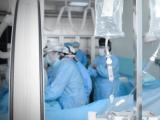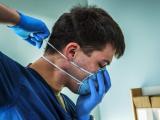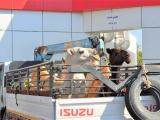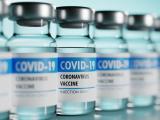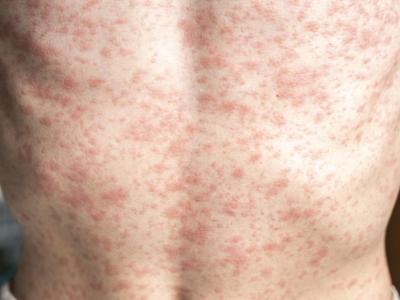South Korean health officials reported three more MERS-CoV infections today, lifting the total to 175 cases, and said a 39-year woman who just recovered from her illness safely gave birth to a baby boy.
In related developments, experts from three health groups yesterday said South Korea's experience and the continued threat of imported cases is a reminder that US facilities should shore up their infection control practices. They also recommended key preparedness steps so the country doesn't repeat some of the stumbles that occurred in the Ebola outbreak.
Delivery after MERS recovery
The Korean woman was exposed to MERS-CoV (Middle East respiratory syndrome coronavirus) while visiting her mother in Samsung Medical Center's emergency department (ED) in late May, the Korea Herald reported today.
Her visit to the hospital in Seoul took place at a time when a man who unknowingly brought the disease from the first affected hospital was in the ED for nearly 3 days and was observed coughing and moving around during his stay. The man's visit triggered a gush of MERS cases at Samsung, which has been linked to more than 80 cases.
Both the woman's mother and father were infected with MERS-CoV because of their exposures at Samsung's ED.
The pregnant woman tested positive for MERS-CoV on Jun 11, and she was hospitalized at Samsung, where her main symptom was mild muscle pain, the Herald reported.
Tests today showed that she is clear of the virus. Her doctor said she was slated for a vaginal delivery, but had to deliver the baby by caesarian section because she experienced placenta abruptio, a pregnancy complication, according to the Herald, which noted that the delivery team wore full protective gear due to the greater infection risk.
Initial tests for MERS-CoV on the baby were negative.
Health officials said the case is the first report of a pregnant woman giving birth to a healthy child as she recovered from MERS-CoV.
Pregnant woman are among the groups at heightened risk of contracting the disease. There have been a few reports of infection in pregnant women in the Arabian Peninsula. For example, in December 2013 the United Arab Emirates reported that a pregnant woman was part of a family cluster and that she gave birth to the child while hospitalized for treatment.
And in January 2014 clinicians published a case study on stillbirth in a Jordanian woman who was part of a MERS-CoV cluster in 2012. The baby was 5 months gestation and the miscarriage was found during an epidemiologic investigation into the cluster. Serologic tests showed the woman had been exposed to the virus, according to the report, published in the Journal of Infectious Diseases.
Three newest cases
The three newest lab-confirmed cases reflect different exposure routes, but all still have links to hospitals. All three patients are older adults.
South Korea's health ministry said one of them is a 70-year-old woman who is a care provider whose infection was detected at Hallym University Kangdong Sacred Heart Hospital, the Korea Times reported. The hospital has shuttered part of its building and has isolated people who were exposed to the woman.
Another patient is a 75-year-old man who was at Samsung Medical Center as an outpatient on Jun 4, 8, and 9, according to the Times. Health officials are investigating if he was exposed to the man whose illness sparked a surge of infections stemming from his ED exposure or to a medical assistant who was later confirmed as a case-patient.
The third infection involves a 74-year-old man who was hospitalized for pneumonia at Good Morning Hospital in Pyeongtaek, located in Gyeonggi province, the Times reported. Investigators suspect he was exposed to the virus by his wife, one of the earlier patients who died from her illness.
The three new infections boost the outbreak total to 175. No new fatalities were reported today, keeping the death total at 27.
Meanwhile, the number of contacts under isolation and monitoring dropped again today. The health ministry said 2,805 are still being followed, down 1,028 from the 3,833 reported yesterday, according to health ministry data posted on the World Health Organization's (WHO's) Western Pacific regional Web site.
Call for US preparedness
In other news, experts from three health groups yesterday called for the United States to take more steps to better prepare the nation for MERS-CoV and other emerging infectious diseases.
The groups—Trust for America's Health (TFAH), the Infectious Diseases Society of America (IDSA), and the University of Pittsburgh Medical Center (UPMC) Center for Health Security—detailed their concerns and recommendations yesterday in a 4-page brief.
The experts said South Korea's outbreak highlights the need for America's public health and healthcare systems to boost their routine infection control and prevention capacity.
A steady trickle of cases exported to other countries from the Arabian Peninsula shows that the United States should be prepared to see more cases, aside from two cases last year in healthcare workers who had been in Saudi Arabia. Both were quickly diagnosed and contained.
Because there is no treatment or vaccine for MERS-CoV, prevention and early care are the keys to battling the disease, the groups said.
They recommended six steps, including strengthening communication strategies and incorporating health alerts into practice. For example, they urged US Centers for Disease Control and Prevention (CDC) to build and maintain two-way communications with local and state health departments on a regular basis, not just during outbreaks.
Another key step is for health providers to routinely take travel histories and be prepared to isolate people with potential diseases such as MERS-CoV, Ebola, or chikungunya.
Health systems and hospitals need to build on their Ebola and all-hazards preparedness, the group said. They added that supplemental Ebola funding helped backfill some of the gaps, but resources still aren't in place for building adequate and sustainable infection control capacity.
The other steps they recommend include modernizing disease surveillance and sharing a framework in advance for quarantine decisions. "Despite hundreds of years of experience and planning of quarantine scenarios, the federal government and state governments responded to the domestic Ebola threat with an inconsistent approach to quarantine and isolation, without a transparent, uniform scientific and medical rationale," they wrote.
See also:
Jun 23 Korea Herald story
Jan 28, 2014, J Infect Dis abstract
Jun 23 Korea Times story
Jun 22 WHO regional office MERS-CoV update
Jun 22 TFAH, IDSA, UPMC preparedness brief


